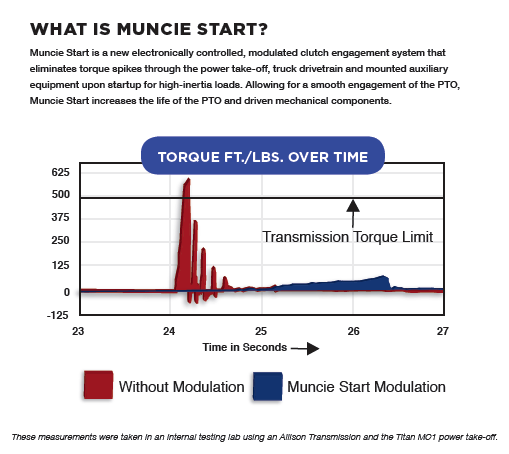The Engineering Behind Muncie Start
Featured in Muncie Power Quarterly, Issue 3, 2018
 Operators of work truck equipment with high-inertia or heavy loads stand to gain increased life for their system’s hydraulic components and decreased life wear on their transmission with Muncie Power Products’ new modulated clutch engagement system—Muncie Start®.
Operators of work truck equipment with high-inertia or heavy loads stand to gain increased life for their system’s hydraulic components and decreased life wear on their transmission with Muncie Power Products’ new modulated clutch engagement system—Muncie Start®.
Released in the second quarter of 2018, Muncie Start reduces the startup torque for high-inertia or heavy loads—which has commonly led to wear on the truck’s power take-off (PTO), subsequently driven mechanical components, and even its transmission.
“The primary point of the Muncie Start is to reduce the startup torque of the PTO by proportionately engaging the clutches,” explained Design Engineer III – Controls Kevin Wijesekera.
Gradually engaging the power take-off’s clutch mechanism results in a smooth engagement. This is opposed to the traditional shock load encountered when the PTO is engaged and abrupt startup torque is generated, as the PTO accelerates the load from stationary to full speed—according to Senior Design Engineer Brian Perry.
In order to create a solution to reduce the startup torque and alleviate wear, the engineering team at Muncie Power had to take an approach combining both electrical and mechanical engineering. Muncie Start was developed through this approach as an external solution, inserted between the PTO switch and the solenoid, to tame the startup torque. Using electrical engineering, Muncie Start reduces the startup torque via waveform.
“The electric module sends a specific waveform on startup to soft engage the clutches,” Kevin noted from an electrical standpoint. “This waveform is preprogrammed and unique to certain PTO lines.”
While Muncie Start uses electrical engineering to reduce the startup torque, it also relies on mechanical engineering to respond to the electrical waveform and reduce the startup torque mechanically.
 Brian likens this to a light bulb with a dimmer switch versus a light bulb with a normal on/off switch. As Brian shared, “It [Muncie Start] works by controlling the hydraulic flow of oil into the clutch piston. Instead of abruptly opening a valve from fully closed to fully open, we can now control that valve and gradually increase the pressure in the clutch pack.”
Brian likens this to a light bulb with a dimmer switch versus a light bulb with a normal on/off switch. As Brian shared, “It [Muncie Start] works by controlling the hydraulic flow of oil into the clutch piston. Instead of abruptly opening a valve from fully closed to fully open, we can now control that valve and gradually increase the pressure in the clutch pack.”
Utilizing this combined approach, Muncie Power’s engineering team was able to develop a solution that has not only reduced startup torque but surpassed the reduced torque levels of its competitor. As Brian explained, the use of Muncie Start results in up to an 85 percent reduction in torque and controls the time in a longer, non-destructive fashion to accelerate the load from stationary to full speed compared to the competitor’s solution, which accelerates that same high-inertia load from stationary to full speed in about 0.3 seconds (plus it amplifies the torque) according to lab testing results.
“In this case, slower is better since that equates to a more gradual and smooth acceleration, which means less torque loading and less shock to the driven equipment,” noted Brian.


